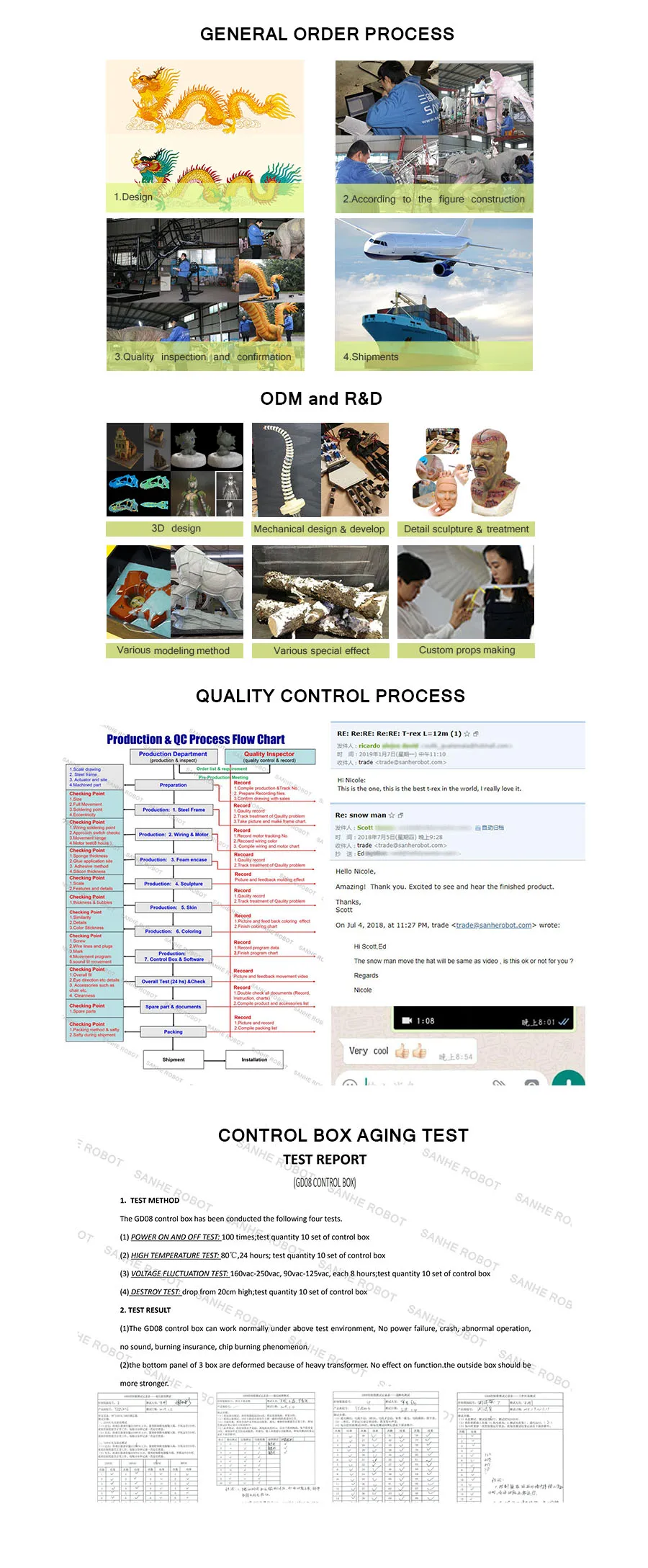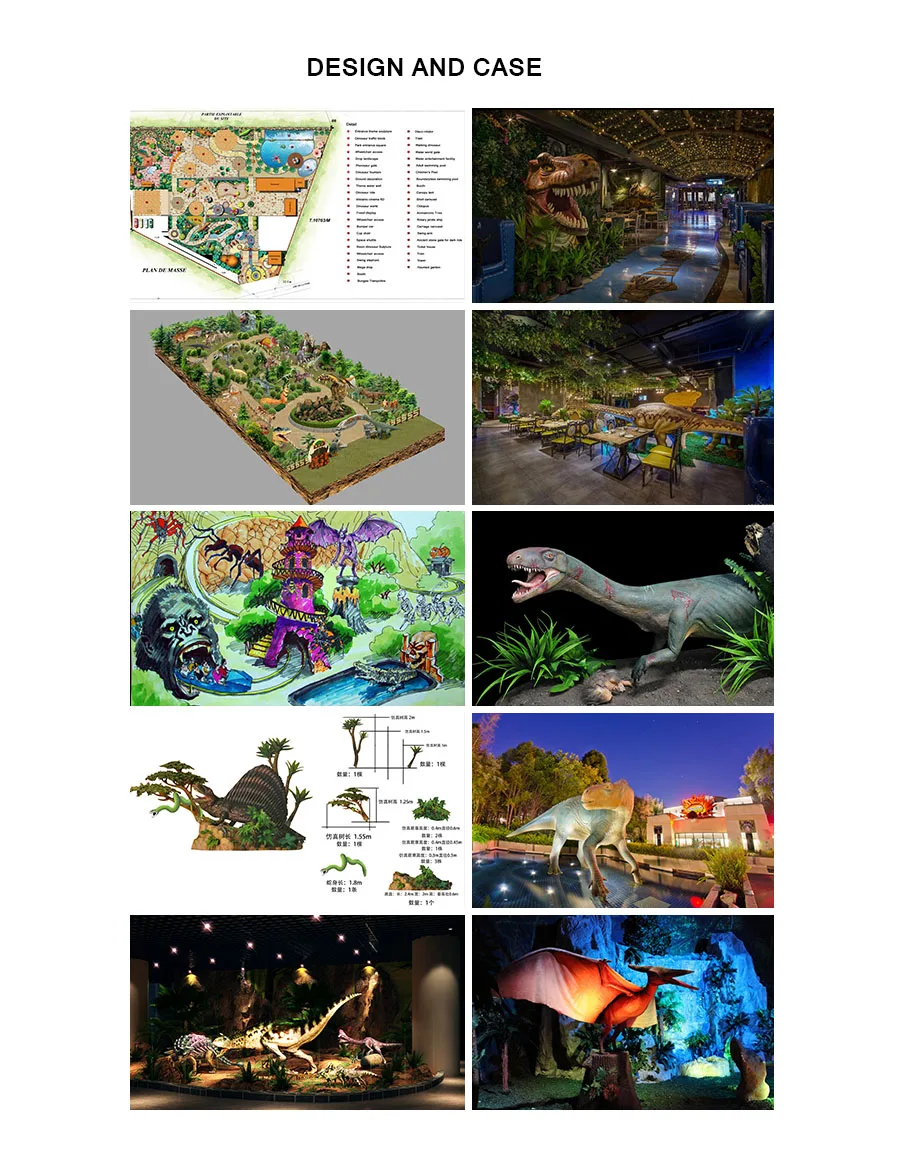Park Activity Amusement Festival Decoration Medieval Animatronic Speaking Tree
MORE INFORMATION
| Input | AC 110/220V ,50-60HZ |
| Plug | Euro plug / British Standard / SAA / C-UL / or depends on request |
| Control mode | Automatic / Infrared / remote / coin / Button / Voice / Touch / Temperature / shooting etc. |
| Waterproofing grade | IP66 |
| Working condition | Sunshine, rain, seaside, 0~50℃(32℉~82℉) |
| Optional function | Sound can be increased to 128 kinds Smoke,/ water. / bleed / smell / change color / change lights / LED screen etc interactive(Location tracking) / conversine(currently only Chinese) |
AFTER-SALE SERVICE
| Service | Need be cut for shipping,fwill provide a detailed installation manual. |
| Warranty | We provide 2 years warranty for all of our antrimatronic models, the warranty pieriod starts from freight arrives at destination port. Our warranty covers motor, reducer, control box, etc. |






 animatronic tree decoration tree amusement park attractions
talking tree animatronics lifelike talking tree talking tree for sale theme park forest decor decor animatronics lifelike animatronics animated tree amusement theme park animatronic outdoor decor life-size animatronic cartoon animatronic talking tree life size mechanical talking tree robotic talking tree realistic animatronic decoration talking tree animatronic talking tree for sale real size artificial talking tree
Animatronics refers to mechatronic puppets. They are a modern variant of the automaton and are often used for the portrayal of characters in films and in theme park attractions.
Before the term "animatronics" became common, they were usually referred to as "robots". Since then, robots have become known as more practical programmable machines that do not necessarily resemble living creatures. Robots (or other artificial beings) designed to convincingly resemble humans are known as "androids".
Animatronics is a multidisciplinary field integrating puppetry, anatomy and mechatronics.Animatronic figures can be implemented with both computer and human control, including teleoperation. Motion actuators are often used to imitate muscle movements and create realistic motions. Figures are usually encased in body shells and flexible skins made of hard and soft plastic materials and finished with colors, hair, feathers and other components to make them more lifelike.
The term Audio-Animatronics was coined by Walt Disney in 1961 when he started developing animatronics for entertainment and film. Audio-Animatronics does not differentiate between animatronics and androids.
Autonomatronics was also defined by Disney Imagineers to describe more advanced Audio-Animatronic technology featuring cameras and complex sensors to process and respond to information in the character's environment.
Animatronics stem from a long tradition of mechanical automata powered by hydraulics, pneumatics and clockwork. Greek mythology and ancient Chinese writings mention early examples of automata, with the oldest dating to the 16th century.
The first animatronics characters shown to the public were a dog and a horse, as separate attractions at the 1939 New York World's Fair. Sparko, The Robot Dog (the "pet" of Elektro the Robot) is considered the first modern-day animatronic character, as it represented a living animal rather than a purely mechanical figure. An unnamed animatronic horse, which was reported to gallop realistically, was also exhibited.
Laffing Sal was one of several automated characters used to attract carnival and amusement park patrons to funhouses and dark rides throughout the United States. Its movements were accompanied by a raucous recorded laugh that sometimes frightened small children and annoyed adults.
Walt Disney is often credited for popularizing animatronics for entertainment after he bought an animatronic bird while vacationing (in either New Orleansor Europe). Disney's vision for Audio-Animatronics was primarily focused on patriotic displays rather than amusements.
animatronic tree decoration tree amusement park attractions
talking tree animatronics lifelike talking tree talking tree for sale theme park forest decor decor animatronics lifelike animatronics animated tree amusement theme park animatronic outdoor decor life-size animatronic cartoon animatronic talking tree life size mechanical talking tree robotic talking tree realistic animatronic decoration talking tree animatronic talking tree for sale real size artificial talking tree
Animatronics refers to mechatronic puppets. They are a modern variant of the automaton and are often used for the portrayal of characters in films and in theme park attractions.
Before the term "animatronics" became common, they were usually referred to as "robots". Since then, robots have become known as more practical programmable machines that do not necessarily resemble living creatures. Robots (or other artificial beings) designed to convincingly resemble humans are known as "androids".
Animatronics is a multidisciplinary field integrating puppetry, anatomy and mechatronics.Animatronic figures can be implemented with both computer and human control, including teleoperation. Motion actuators are often used to imitate muscle movements and create realistic motions. Figures are usually encased in body shells and flexible skins made of hard and soft plastic materials and finished with colors, hair, feathers and other components to make them more lifelike.
The term Audio-Animatronics was coined by Walt Disney in 1961 when he started developing animatronics for entertainment and film. Audio-Animatronics does not differentiate between animatronics and androids.
Autonomatronics was also defined by Disney Imagineers to describe more advanced Audio-Animatronic technology featuring cameras and complex sensors to process and respond to information in the character's environment.
Animatronics stem from a long tradition of mechanical automata powered by hydraulics, pneumatics and clockwork. Greek mythology and ancient Chinese writings mention early examples of automata, with the oldest dating to the 16th century.
The first animatronics characters shown to the public were a dog and a horse, as separate attractions at the 1939 New York World's Fair. Sparko, The Robot Dog (the "pet" of Elektro the Robot) is considered the first modern-day animatronic character, as it represented a living animal rather than a purely mechanical figure. An unnamed animatronic horse, which was reported to gallop realistically, was also exhibited.
Laffing Sal was one of several automated characters used to attract carnival and amusement park patrons to funhouses and dark rides throughout the United States. Its movements were accompanied by a raucous recorded laugh that sometimes frightened small children and annoyed adults.
Walt Disney is often credited for popularizing animatronics for entertainment after he bought an animatronic bird while vacationing (in either New Orleansor Europe). Disney's vision for Audio-Animatronics was primarily focused on patriotic displays rather than amusements.

+86-813-2104677

info@sanherobot.com

+86-13990010824

No.13 Huixin Road, Yantan Town, Yantan District, Zigong City, Sichuan Province, China